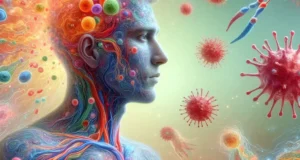Imagine rivers flowing from mountains into valleys, merging, spreading, and nourishing distant lands. Just like these rivers, people move—from village to city, from one country to another—carrying culture, knowledge, dreams, and sometimes, invisible burdens. This movement is called migration, and while it often brings growth and connection, it can also unknowingly spread disease.

In the global story of HIV, one question keeps returning: AIDS—where did it come from? The virus may have originated in the forests of Central Africa, but it was human migration that helped it journey across borders, oceans, and populations. It was not war or weapons that spread HIV across the globe—it was people simply moving to seek a better life.
Let’s understand this through a metaphor.
Imagine a single spark in a forest. On its own, it burns a patch of ground. But if wind carries it to dry grass miles away, it ignites a new fire. Migration is that wind—powerful, natural, and capable of spreading more than just ideas. In the case of HIV, it carried a virus that was once local and turned it into a global pandemic.
In the early 20th century, as colonization expanded across Africa, men migrated from rural villages to cities like Kinshasa to work in mines, railroads, or ports.
So again we ask: AIDS—where did it come from?
Not only from the blood of animals or a mutation in nature—but from the movement of people across distances, driven by hope, hardship, and survival. Migration didn’t invent the virus—it simply gave it wheels.
As the 20th century progressed, global migration increased rapidly. People moved for work, education, refuge, or trade. With them, the virus traveled from Africa to Haiti, from Haiti to the United States, and from there to Europe and the rest of the world. HIV hitchhiked across oceans in silence, long before it had a name or a test.

But it wasn’t just international migration. Internal migration—from villages to cities, especially in developing countries—also played a major role. Urban centers became hotspots for HIV due to high population density, lack of healthcare access, and increased social interaction among strangers.
Even today, migrant workers and displaced people are among the most vulnerable groups in HIV statistics. They often lack stable healthcare, face language barriers, and live in temporary or crowded housing, increasing their risk of infection and reducing their ability to seek help or testing.
Yet, migration itself is not the enemy. Just as rivers bring life and growth, migration brings diversity, innovation, and resilience. The problem lies in inequality, ignorance, and lack of systems that support people on the move. When migrants are left out of public health plans, viruses like HIV can thrive unnoticed.
That’s why modern HIV prevention programs now include mobile testing clinics, multilingual education, and cross-border healthcare partnerships—tools designed to follow the people and protect them, wherever they go.
So once again, we reflect on that timeless question: AIDS—where did it come from? It came not from war or weaponry, but through human footsteps—people crossing mountains, deserts, and oceans. Migration gave HIV its map, but human understanding, compassion, and science now offer the tools to draw new boundaries—ones that protect, not divide.




